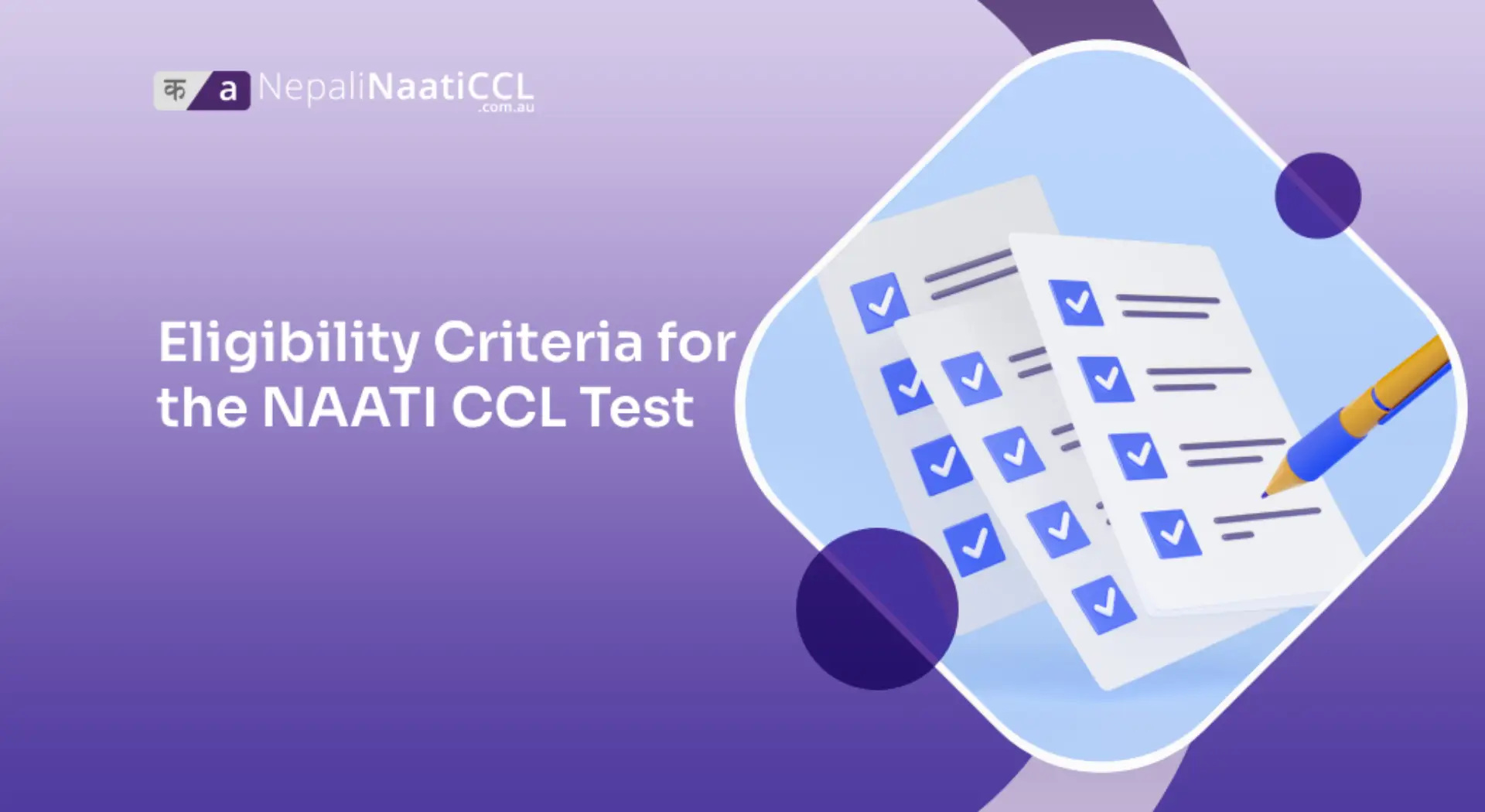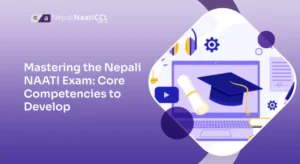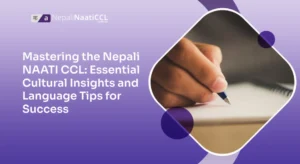Are you getting ready for the NAATI CCL Test? Before diving in on the core parts of the test, let’s talk about the eligibility criteria for the NAATI CCL test.
The NAATI CCL Test will stand out big if your interest is in language interpretation or if you are looking to settle in Australia permanently. I am telling this to you because the NAATI CCL certification will provide linguistic opportunities and the opportunity to earn five Australian PR points.
But first things first – let’s see if you qualify.
So, what do you need? You should have studied the language you want to be tested in for at least five years full-time, ensuring you know your stuff, both in terms of speaking and understanding the culture tied to the language.
Knowing if you’re eligible for the NAATI CCL Test is step one. Furthermore, this blog will break it down further, making sure you’ve got all the info you need to kick off your NAATI CCL journey.
Let’s explore the topic of eligibility criteria for the NAATI CCL test in detail.
How Will the NAATI CCL Test be Conducted?
The NAATI CCL Test is a crucial certification in the world of language assessment, especially for those eyeing opportunities in Australia. Now, let’s unpack how this test goes down, step by step.
The test is first delivered on a computer, making it accessible and efficient. This digital format allows candidates to engage with the assessment in a user-friendly manner.
It starts with an introductory section that eases candidates into the test environment, setting the stage for what’s to come.
However, the actual test comprises two dialogues that mimic real-life scenarios. These scenarios are everyday situations you might encounter, like chatting with a neighbor or seeking information at a service center.
Moreover, the dialogues are played through headphones, and candidates must interpret them from the source language to English or vice versa.
Importantly, candidates have control over the playback. This means you can pause and play the dialogues as needed.
Also, when it comes to scoring, NAATI uses a comprehensive marking system. Points are awarded based on your ability to convey the main ideas accurately and cover all the key points.
Plus, fluency, pronunciation, and language use are also considered in the scoring process.
As we wrap up this overview, understanding the best way to boost your career and life in Australia via the NAATI CCL test format is a crucial part of your preparation. This blog will explore each aspect in more detail.
Understanding the NAATI CCL Test Format
First off, it’s good to know that the NAATI CCL Test is designed to assess your language skills in a real-world context. It’s not just about knowing words but how well you can use them in everyday situations.
The test consists of two dialogues. These are like little language scenarios you might encounter while living in Australia. Picture chatting with a neighbor, seeking help at a service center, or interacting in a community setting.
Each dialogue is approximately 300 words, nearly half in English and half in the chosen LOTE. The dialogue is further divided into different segments.
Also, each of these segments is of a maximum of 35 words, and the maximum time allotted for the NAATI CCL test is 20 minutes.
Speaking of results, NAATI sends it via mail within 4-6 weeks from the test date.
Your job during the test is interpreting these dialogues from one language to another. Whether it’s from the source language to English or vice versa, you’ve got to capture the main ideas and cover all the key points.
Hence, understanding this test format is a part of developing daily habits for NAATI CCL success.
8 Eligibility Criteria for the NAATI CCL Test

Before jumping into the details, let’s get the basics down. First of all, to be eligible for the NAATI CCL Test, there are criteria you must meet.
The goal is to showcase your language proficiency in your chosen LOTE and English, understanding cultural nuances.
Moreover, these criteria make sure that the candidates possess the necessary skills to engage in tackling the examination confidently and help clear the NAATI CCL exam in under 30 days.
Let’s explore the points of eligibility criteria for the NAATI CCL test in detail.
1. Language Proficiency Requirement
Understanding the language proficiency requirement for the NAATI CCL Test is crucial to showcase your linguistic skills in diverse settings. Importantly, it’s worth noting that formal education background is not a prerequisite for taking the NAATI CCL test, making it accessible to individuals with practical language expertise.
Candidates are expected to navigate real-life scenarios, reflecting the practical application of language skills in everyday situations.
Moreover, the NAATI CCL Test evaluates your proficiency through dialogues that simulate authentic conversations. These dialogues represent situations one might encounter in Australian communities, ranging from casual interactions with neighbors to seeking assistance at service centers.
For language interpretation, candidates translate dialogues from the source language to English or vice versa. This requires precision in conveying the main ideas and covering all key points. It also showcases the candidate’s ability to serve as a language bridge between different linguistic contexts.
2. Age Consideration
When it comes to the NAATI CCL Test, age is not a determining factor for eligibility. NAATI does not impose any age restrictions, making the test accessible to individuals across different age groups.
The absence of age-related criteria means that both young and mature candidates have an equal opportunity to undertake the NAATI CCL Test. Whether you’re a recent graduate or someone with years of life experience, you can showcase your skills through the test if you possess the required language proficiency.
This open approach aligns with the broader goal of the NAATI CCL Test, which is to assess individuals based on their practical language abilities rather than factors like age or formal educational background.
3. Accurate Interpretation
Accurate interpretation is a crucial aspect of the NAATI CCL Test, emphasizing the candidate’s ability to convey ideas precisely and effectively between the source language and English. This proficiency goes beyond language comprehension; it involves a nuanced understanding of cultural contexts and the skill to articulate concepts authentically.
During the test, candidates are presented with dialogues representing everyday scenarios, such as community interactions or service center inquiries. The task is to interpret these dialogues precisely.
Moreover, this process evaluates the candidate’s capacity as a language bridge, facilitating clear communication in diverse linguistic settings.
This practical approach ensures that the test assesses theoretical language knowledge and the ability to apply this knowledge in authentic, context-specific situations. Hence, accurate interpretation is fundamental to demonstrating a candidate’s language proficiency and helps you pass the NAATI CCL test on your first attempt.
4. Pronunciation Proficiency
Pronunciation proficiency holds a significant role in the NAATI CCL Test, focusing on a candidate’s ability to articulate words accurately and clearly. Beyond linguistic knowledge, this criteria underscores the practical application of language skills in real-world scenarios and multicultural settings.
During the test, candidates are evaluated on how precisely they pronounce words in both the source language and English. Clear pronunciation is vital for facilitating understanding and conveying messages accurately.
Hence, this aspect of the test acknowledges that language proficiency extends beyond comprehension to the ability to express oneself clearly, enhancing overall communicative effectiveness.
Moreover, the consideration of pronunciation is integrated into the comprehensive marking system used by NAATI. Points are awarded not only for accurate pronunciation but also for the overall ability to convey main ideas, cover key points, and maintain fluency.
5. Real-Life Scenarios
Real-life scenarios play a central role in the NAATI CCL Test, providing a practical context for evaluating a candidate’s language proficiency. The test goes beyond theoretical language knowledge by immersing candidates in everyday situations, mirroring experiences they might encounter in Australian communities.
Similarly, the dialogues presented in the test simulate authentic interactions, ranging from casual conversations with neighbors to seeking information at service centers. This approach ensures that you can navigate the crucial steps to make your NAATI CCL test successful.
It emphasizes applying language skills in scenarios beyond the classroom and assesses a candidate’s ability to communicate effectively in various contexts. This practical approach ensures that the test assesses not only the knowledge of the language but also the ability to apply that knowledge in authentic, context-specific situations.
Furthermore, the test’s focus on real-life scenarios aligns with its comprehensive marking system. Candidates are evaluated on their performance in interpreting dialogues accurately, covering key points, maintaining fluency, and using proper pronunciation within these scenarios.
This holistic evaluation ensures that a candidate’s language proficiency is assessed dynamically and practically.
6. Comprehensive Marking System
The Comprehensive Marking System is designed to evaluate a candidate’s language proficiency thoroughly. This system considers various elements that capture the richness of a candidate’s linguistic capabilities.
In the NAATI CCL Test, candidates are awarded points based on their ability to convey primary ideas accurately, cover critical points, maintain fluency, and use proper pronunciation. Also,
accurate interpretation of dialogues is a central criterion within the marking system.
Candidates are evaluated on their precision in conveying the main ideas and ensuring that all essential points are covered. Moreover, the marking system emphasizes fluency, recognizing the importance of smooth and articulate expression in effective communication.
The consideration of pronunciation proficiency further enriches the marking system. Clear pronunciation is deemed vital for effective communication, and candidates are awarded points for articulating words accurately in both the source language and English.
7. Language Variation Acceptance
An essential aspect of the eligibility criteria for the NAATI CCL Test is the acceptance of language variations. NAATI recognizes the inherent diversity within languages and acknowledges that candidates may have learned a particular language in different cultural or regional contexts.
Moreover, this inclusivity ensures that individuals with diverse linguistic backgrounds and exposures have the opportunity to participate in the NAATI CCL Test. By allowing for language variation acceptance, the eligibility criteria reflect the real-world diversity of languages.
Moreover, NAATI is committed to fostering multicultural communication in Australia. It acknowledges that language is dynamic and evolves within different communities, and candidates should not be limited to a rigid linguistic standard.
By embracing language variation, NAATI aims to promote a more inclusive platform for individuals with diverse language backgrounds to contribute their valuable skills to the multicultural landscape of Australia.
8. Flexible Educational Background
A distinctive feature of the eligibility criteria for the NAATI CCL Test is the recognition and embrace of a flexible educational background. Unlike some language tests that may require specific formal educational qualifications, NAATI’s criteria are inclusive and accommodate individuals with diverse learning paths.
The eligibility criteria do not require a formal education, allowing candidates to demonstrate their language proficiency if they possess the skill.
Furthermore, NAATI understands that linguistic skills are not solely confined to traditional classroom settings and that individuals can develop proficiency in a language through real-life experiences and interactions.
By adopting a flexible stance on educational background, NAATI opens the door for candidates who may have gained language proficiency through unconventional but valid means. This inclusivity ensures accessibility to a broader range of individuals, encouraging diversity in language representation and recognizing the value of practical language skills.
5 Strategies for Language Skill Enhancement

Looking to boost your language skills? Here are five straightforward strategies to enhance your proficiency.
There is no need for complex methods – we’re talking about practical and effective ways. From daily conversations with native speakers to immersing yourself in movies or books, these strategies focus on integrating language learning into your daily life.
It’s all about making language practice a part of your routine and enjoying the process. Let’s dive into each one without further ado and learn more about the important things you didn’t know about the NAATI CCL Test.
1. Daily Conversations
Engaging in daily conversations is a highly effective method for improving language skills. You create a consistent and practical learning environment by incorporating regular interactions into your routine.
This daily practice enables you to apply language concepts in real-time, aiding in developing both speaking and listening abilities.
Moreover, daily conversations provide an opportunity for exposure to the spoken language. Through consistent dialogue, learners become more familiar with the natural flow of conversation. This exposure is essential for understanding how native speakers communicate in everyday situations.
In addition, daily conversations contribute significantly to the improvement of listening skills. Actively participating in discussions exposes learners to various accents, speeds of speech, and different conversational contexts.
2. Immersive Content Consumption
Immersing oneself in content is a highly effective strategy for enhancing language skills. This approach involves actively participating in language-rich materials such as movies, TV shows, podcasts, and books to create a dynamic learning experience.
Similarly, immersive content consumption exposes learners to authentic language usage. Unlike formal educational settings, where language learning is structured, immersive content reflects how native speakers naturally communicate.
This exposure aids in understanding expressions, cultural nuances, and various linguistic styles.
Additionally, learners can observe how language is employed in various situations, such as everyday conversations, formal settings, or even emotional exchanges. This contextual learning develops vocabulary and helps individuals with diverse language interactions.
3. Vocabulary Expansion through Reading
Expanding your vocabulary through reading is a powerful strategy for enhancing language skills. This method involves regularly reading written materials such as articles, newspapers, or literature to develop your understanding of words and their usage.
Likewise, reading exposes a diverse range of words in various contexts. Unlike isolated vocabulary lists, which may lack real-world application, encountering words in sentences and paragraphs helps you understand how words function within the structure of the language.
Moreover, reading exposes individuals to specialized terminology and expressions specific to different topics. Exposure to a wide range of written materials will introduce you to synonyms, antonyms, and shades of meaning for a single word.
Similarly, regular reading cultivates a habit of continuous learning. As individuals encounter new words and expressions in their reading materials, they naturally integrate these into their active vocabulary. This ongoing discovery process will help you evolve your language skills over time.
4. Language Exchange Programs
Participating in language exchange programs is a highly effective strategy for enhancing language skills. These programs create a reciprocal learning environment where individuals can practice language with native speakers or proficient speakers of the language they are learning.
Language exchange programs offer authentic and real-time communication opportunities. Interacting with native speakers provides a firsthand experience of how the language is used in everyday conversations.
Nonetheless, this direct exposure helps learners grasp cultural nuances and regional variations, creating a more authentic language learning experience. Also, the interactive nature of language exchange fosters a dynamic learning process.
Instead of a one-sided learning approach, participants actively engage in conversations, offering both speaking and listening practice. This active participation accelerates language acquisition in practical language use.
Furthermore, these programs provide valuable feedback and correction. Constructive feedback from language partners becomes an invaluable resource for learners seeking to refine their language skills.
5. Utilize Language Learning Apps
Language learning apps offer interactive lessons, quizzes, and exercises designed to cater to different proficiency levels, providing a flexible approach to learning on the go.
Firstly, language learning apps offer bite-sized lessons that fit into busy schedules. Whether you have a few minutes during a commute or a brief break, these apps allow you to engage with language lessons at your own pace.
Moreover, these apps’ interactive natures engage users in various language exercises, such as vocabulary drills, pronunciation practice, and listening comprehension. Language learning apps provide instant feedback, allowing users to track their progress and identify areas for improvement.
Hence, Immediate correction of pronunciation, grammar, and vocabulary helps to grasp concepts accurately, contributing to a more efficient learning process. However, to get the full idea, I also recommend checking out the assessment criteria of the NAATI CCL test.
How to Best Navigate NAATI CCL Exam Day?
Navigating the NAATI CCL exam day effectively involves careful planning and a calm approach.
First and foremost, arrive at the exam venue well in advance. Punctuality is crucial as early arrival contributes to a composed mindset and minimizes unnecessary stress.
Once settled, familiarize yourself with the exam format. Take a moment to review the instructions and understand the structure of the test. This preliminary overview helps in managing your time wisely during the exam.
Additionally, pay attention to any announcements or guidelines provided by the exam invigilators. Clear communication and understanding of the process contribute to a smoother exam experience.
As you begin the test, read each dialogue carefully before responding. Take a moment to comprehend the context and main ideas.
Moreover, while responding, aim for clarity and coherence. Use proper pronunciation and maintain a steady pace to ensure your responses are well-articulated.
Also, during the exam, use the control over dialogue playback. If needed, utilize pauses to gather your thoughts and respond accurately. This feature provides a valuable tool for managing your time and ensuring your responses align with the test’s expectations.
Time management in the NAATI CCL test is another crucial factor you must not ignore.
Lastly, If you encounter a challenging section, remain composed and proceed to the next one. A calm and collected approach contributes to better decision-making and enhances your overall performance on the NAATI CCL exam.
Conclusion
In conclusion, the eligibility criteria for the NAATI CCL Test play a crucial role in an inclusive and accessible platform for language assessment.
By embracing various dialects and regional nuances, the eligibility criteria acknowledge that individuals may have learned the language in different cultural or regional contexts. This inclusive approach ensures that candidates can demonstrate their language proficiency regardless of specific linguistic nuances.
Also, this flexibility recognizes the value of practical language skills beyond traditional educational structures and fosters an inclusive environment for individuals with diverse language learning paths.
Similarly, to help you with NAATI CCL success and guide you through the intricacies, NepaliNAATICCL is the best medium. As an online portal catering to all things related to the NAATI CCL Online Test.
NepaliNAATICCL is a platform that serves as a reliable source for information and guidance, providing NAATI CCL course materials that empower candidates with essential knowledge.
Furthermore, it offers free NAATI CCL test samples, allowing aspirants to refine their skills.
Happy Learning!!
FAQ
Q.1: Is a formal education background required for the NAATI CCL Test?
No, the NAATI CCL Test does not require a formal education background. Practical language proficiency gained through various means is sufficient.
Q.2: Can I take the NAATI CCL Test if I learned the language in a specific dialect?
Yes, the test accepts language variations. You can showcase your proficiency in the dialect or regional variation you have learned.
Q.3: What is the purpose of the NAATI CCL Test’s flexible educational background criterion?
The criterion allows individuals with practical language expertise gained through non-formal education to participate, fostering inclusivity.
Q.4: Is the NAATI CCL Test accessible to non-native speakers?
Yes, the test is designed for both native and non-native speakers, emphasizing practical language skills over nativity.
Q.5: How does the NAATI CCL Test contribute to Australian PR points?
Clearing the test provides five PR points, enhancing career opportunities in linguistic fields and easing the migration process to Australia.






